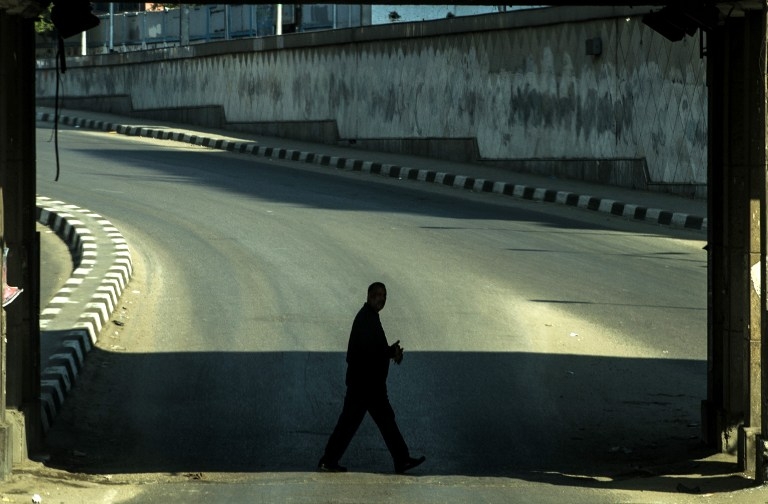The Egyptian protests you won't see in the news

CAIRO - On a Thursday night a year ago, an acquaintance invited me to an Islamist-led protest against military rule in a neighbourhood called Warraq, on the western bank of the Nile.
Warraq is not far from the centre of Cairo, but it was a halting, bumpy ride to the start of the march. Threading narrow alleys, the car bounced over gaping potholes, swerving to avoid the oncoming trucks and rickshaws.
The protest buzzed with nervous energy. About 300 marchers sang, beat drums, blew vuvuzelas and unfurled tall yellow banners bearing the four-fingered “Rabaa” symbol, a reference to the hundreds killed in Cairo’s Rabaa Al-Adawiya Square in August when security forces obliterated a sit-in in support of deposed president Mohamed Morsi.
As the marchers filed between the hand-built brick buildings, some of the street vendors and passersby cheered and flashed the Rabaa symbol. Others shouted their disapproval or worse. At a sidewalk café, one man hurled a water glass into the crowd. Young men lunged at him and someone bowled over the man’s table. Seconds later neighbours separated the combatants.
I thought of that night in Warraq on Friday when Egypt braced for a planned day of mass Islamist protests. A call by the ultraconservative Salafi Front for a “Muslim youth uprising” had unleashed weeks of feverish speculation in Egypt’s media.
In addition to the police, the army’s tan armoured personnel carriers rolled onto the streets. The police special forces, men wearing black ski masks and holding rifles, rode jeeps in slow circles around my neighbourhood.
The anticipated protests never appeared in Cairo’s central neighbourhoods. In Tahrir Square, a small anti-Islamist, pro-government rally took place, with flag-waving demonstrators cheering the police.
Some Islamist protesters did appear outside of the capital and in lesser-known Cairo neighbourhoods like Matariya, where at least one person was killed in a demonstration.
Matariya, like Warraq, is one of Cairo’s so-called shaabi, meaning “popular” or working-class areas, where the majority of the city’s estimated 20 million residents live. When foreign journalists write about life in Cairo, most of the time we are writing not about these districts, but about the city’s better-known central areas: Tahrir Square, the faded glory of downtown, the embassy district of Garden City, the leafy streets on the island of Zamalek, the wide boulevards of Mohandessin.
There are reasons for the geographic bloodspots. Foreign journalists face legitimate security concerns and occasional street-level hostility. Harassment and arrests of journalists makes it a challenge to get around the city.
But political life is ongoing in shaabi Cairo. Nearly every night for months after Morsi’s removal, small Islamist-led demonstrations against Egypt’s military-backed government have taken place in neighbourhoods like Warraq.
This is, in part, by the design of the protest organisers. The marches are held in residential areas away from the heavy security presence in the city’s larger public spaces.
The dynamics in local marches are also different from those that take place closer to the city centre. The Muslim Brotherhood has long been criticised for bussing protesters from out of town to pack their rallies in Tahrir and later in Rabaa and Nahda. Non-locals marching through central Cairo neighbourhoods is part of why fighting sometimes breaks out during these protests.
What struck me about the protest in Warraq was that, at a micro-level, in some far-flung neighbourhoods, politics, in the messy, contentious sense of the word, is still taking place. Protesters might argue and push and shove their antagonists but, at least on that one Thursday night, no one got killed.
It is also remarkable that these protests persist at all, given the scale of the government’s clampdown on political dissidence. Following Morsi’s ouster, the security forces committed a series of mass killings at Islamist protests, including the massacre in Rabaa Al-Adawiya.
The authorities have also jailed thousands of others, including numerous non-Islamist dissidents who also protested against Morsi. The government has outlawed unauthorised protests and expanded the power of military courts to try civilians.
Of course, politics has shifted over the last year. The Muslim Brotherhood-led “anti-coup” marches always existed in a kind of bubble. With their call for reinstating the unpopular Morsi, they attracted little support outside of the Islamist camp.
This week’s Salafi protest was far narrower, appealing not to Egyptians at large, but to “Muslims,” using the tagline of an “identity uprising.” The uprising never came.
Egypt’s security state is in the ascendant. Small protests will persist in little-known neighbourhoods, and the prisons will remain full.
- Jared Malsin is a freelance journalist based in Cairo. He is a regular contributor to TIME, and his writing has also appeared in Bloomberg Businessweek, VICE, The New Republic, Foreign Policy, Columbia Journalism Review, Al Jazeera America, GlobalPost, The National, and The New York Times blog, The Local East Village, among other publications. From 2007-2010, he worked in the West Bank and Gaza for the independent Palestinian news agency Ma’an and served as the agency's chief English editor.
The views expressed in this article belong to the author and do not necessarily reflect the editorial policy of Middle East Eye.
Photo Credit: An Egyptian man crosses a deserted al-Haram street in Cairo's Giza district on 28 November 2014 ahead of planned Islamist protests that have prompted the police and military to boost their presence in the capital and other cities (AFP)
Middle East Eye propose une couverture et une analyse indépendantes et incomparables du Moyen-Orient, de l’Afrique du Nord et d’autres régions du monde. Pour en savoir plus sur la reprise de ce contenu et les frais qui s’appliquent, veuillez remplir ce formulaire [en anglais]. Pour en savoir plus sur MEE, cliquez ici [en anglais].




